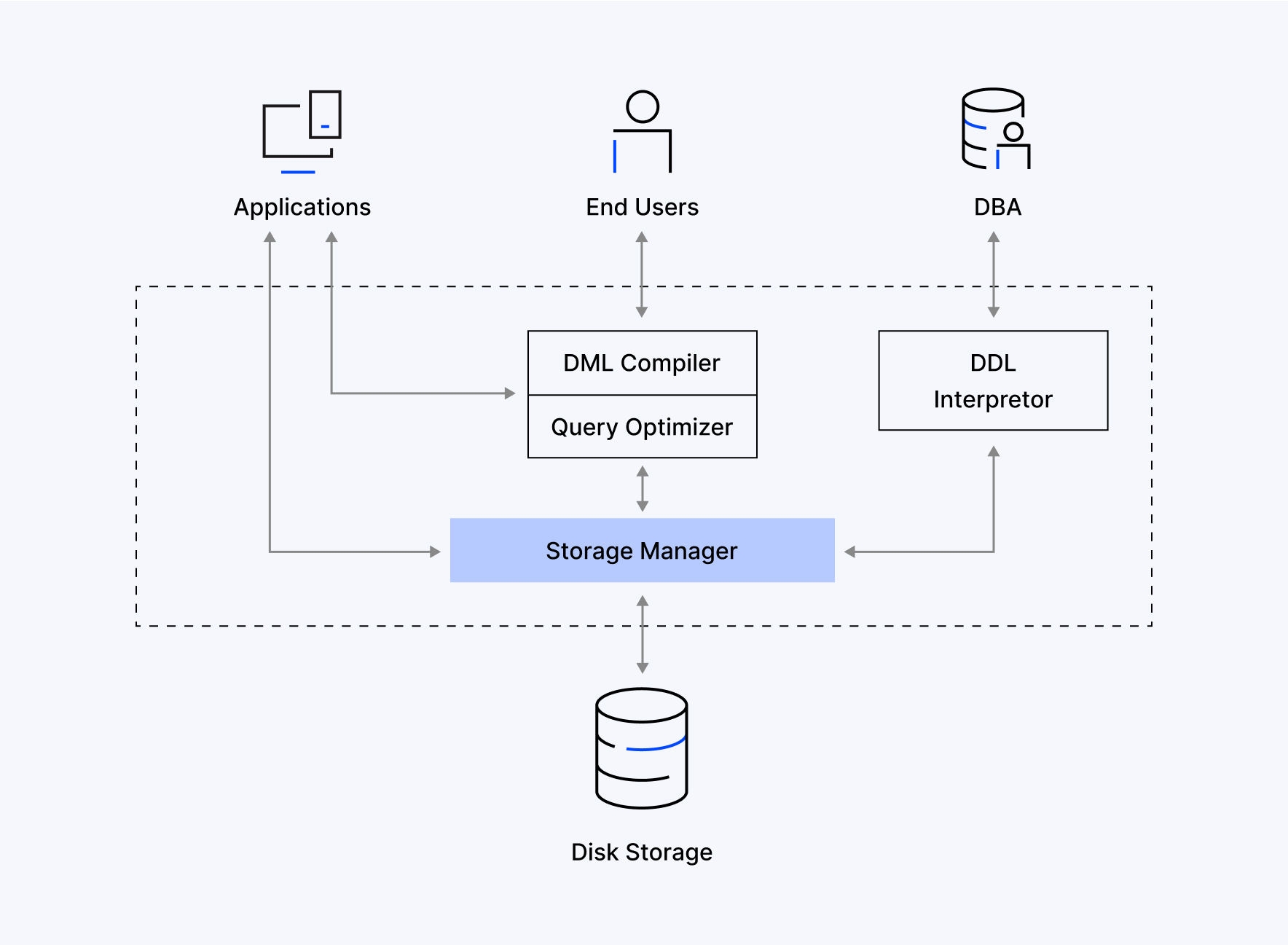Structure of DBMS: Core Components and Importance

Have you ever considered how your favorite e-commerce site can process millions of product listings, customer orders, and payment transactions with such ease? Or how a global logistics company can keep track of hundreds of thousands of shipments instantly? The answers often rely on a database management system (DBMS).
A DBMS makes it easier for today’s applications to handle and organize large sets of data in a clear and structured way. Recognizing its architecture at a base level is strategically important and more than a routine for all businesses. A well-structured database system can lead to significant gains in application performance, scalability for increased growth, and the reliability of mission-critical business functions. As spending on database systems continues to grow from $117 billion in 2024 to nearly $256 billion by 2032, it becomes important to understand how they are structured and why it matters.
Understanding the foundational structure of a database system provides insight into how data is stored, accessed, and secured. This helps businesses to invest wisely in limited technology resources and build a well-architected digital landscape.
Let’s dive into the structure of the Database Management System.
In a Nutshell
The structure of a DBMS defines how its internal components, like the query processor, storage manager, and data layer, are structured to store, manage, and retrieve data efficiently. Understanding the structure of a DBMS helps manage performance, scalability, security, and maintenance of data systems much more easily.
What Is the Structure of DBMS?
The structure of a DBMS is like how it is organized inside. It has different parts and layers that work together to help store, organize, and manage data efficiently. These parts make sure that the data is handled properly and can be used easily when needed. It is an abstract design that provides a way of discussing the various parts of the system and how they interact and provide data management services.

Why Is DBMS Structure Important?
1. Efficient Data Storage
The defined structure of DBMS makes the organization of data on physical devices efficient. It can improve the speed of data access by outlining approaches for indexing, partitioning, and compression, a lower cost of storage, or both. If data is stored without the efficient structure of a DBMS, finding a specific piece of information can feel like searching for a single drop of water in the ocean.
2. Data Integrity
The architecture of a DBMS ensures the integrity of data by enforcing integrity rules to ensure data is accurate, consistent, and reliable. A DBMS offers mechanisms such as constraints (e.g., primary and foreign keys, and check constraints) to deny the entry or modification of invalid data to protect the integrity of the information upon which business decisions are based.
3. Ease of Maintenance
If a DBMS is modular and layered, the maintenance and upgrade of the database will be simplified. Modularity means that upgrades or changes can be made to one layer or component with minimal effect on the other layers or components. This reduces both the amount of time the database is non-functional and also reduces disturbances to operations. The modular design of a DBMS (Database Management System) means it's made up of separate parts that work together. This makes it easier for businesses to manage, fix, or update the system without shutting everything down. So, their services can stay up and running all the time.
4. Security
The DBMS was built with different security tools and options. Many of those security tools were used to help protect the data. The DBMS includes various ways to authenticate, authorize, and encrypt to ensure that only authorized individuals access data and complete intended operations. It also secures critical business information from unauthorized access and cyberattacks.
5. Improved Performance
An optimized database structure in DBMS leads to optimization of performance in the application. A good structure of the DBMS to access data, process queries, and manage transactions will optimize response times from an application perspective and ultimately enhance the user's experience and optimize operational efficiency.
Is your storage layer optimized in DBMS?
Let's TalkLoading...
Core Components of DBMS System Structure
1. Hardware
Hardware refers to the physical components on which the DBMS and its data reside. This includes servers, storage devices (like hard drives or SSDs), and network infrastructure. The performance and reliability of the hardware directly influence the overall efficiency of the DBMS. For instance, high-speed storage can significantly speed up data retrieval by providing quick access paths to data.
2. Software
Software contains the DBMS software itself, including the database engine, utilities, and application programs that interact with the database. This is the heart of the system, responsible for managing all data operations.
3. Data
Data is the actual information stored within the database. It can be raw facts, figures, text, images, or any other type of digital content. The database schema defines the organization and relationships of this data.
4. Users
Users are the individuals, applications, or other systems that interact with the DBMS. Users can range from end-users querying information to database administrators managing the system, each with different access privileges.
5. Query Processor
The query processor is a crucial component responsible for interpreting and executing user queries. When a user or application requests data (e.g., "Find all customers in New York"), the query processor translates this request into a series of operations that the DBMS can understand and execute. It includes components like the DDL Interpreter, DML Compiler, and Query Optimizer. The Query Optimizer is particularly important as it determines the most efficient way to execute a query, considering various factors like indexing, partitioning, and caching, thereby significantly improving query performance.
6. Storage Manager
The storage manager is the component that interfaces with the physical storage devices. It is responsible for managing the allocation of space on disk, retrieving data from storage, and writing data to storage. This includes managing data files, indexes, and the data dictionary. It applies various techniques like partitioning, caching, indexing, and data compression to ensure these optimizations.
7. Disk Storage
Disk Storage refers to the physical storage media where the database files are permanently stored. The storage manager handles interaction with physical storage, including disk files, index files, and the data dictionary. Here, the index files speed up the data retrieval, and the data dictionary contains metadata about the database.
Difference between DBMS Structure and DBMS Architecture
| Feature | DBMS Structure | DBMS Architecture |
|---|---|---|
| Definition | Refers to the internal organization and components of the DBMS. | Refers to the design and implementation of the database system, often involving multiple tiers or levels. |
| Focus | On how the various internal components (e.g., query processor, storage manager) are organized and interact. | On how users and applications interact with the database system, particularly concerning data independence. |
| Scope | Internal workings of the DBMS. | External view and interaction with the DBMS. |
| Key Aspects | Hardware, software, data, users, query processor, storage manager, disk storage. | Three-schema architecture (external, conceptual, internal levels), client-server models. |
| Purpose | To define the operational components and their interrelationships. | To achieve data independence and allow changes in one layer without affecting others. |
| Example | The query optimizer is part of the query processor within the DBMS. | A 3-tier architecture separates the presentation, application, and database layers. |
Challenges in Database System Structure in DBMS
🡆 Data Redundancy and Inconsistencies
Data redundancy, the simultaneous use of the same data in different independent databases, is one of the biggest problems. When changes are made to one source and not another, for example, when updating a customer's address stored in two tables, the result can be inconsistency. This will, in turn, yield inaccurate reports and poor business decisions. Database developers generally use normalization to eliminate data issues.
🡆 Performance Bottlenecks in Complex DBMS Structures
Developing database systems that utilize increasingly larger data sets can lead to bottlenecks, or situations where slow performance starts to occur. Bottlenecks may occur due to query execution time, the impact of transaction processes, or applications just going dead and not occupying resources.
Performance bottlenecks are sequential and can originate from any combination of query plan or use of inefficient execution strategies, lack of hardware, poor design of the overall database, and competition for shared resources.
Performance bottlenecks are managed and solved by fast indexes, writing efficient queries, effective provisioning of hardware, and partitioning data that belongs to different independent processes.
🡆 Solutions and Best Practices
Solutions to structural issues in a DBMS focus more on how the system is built rather than how it’s used. These include designing separate parts for handling storage, memory, transactions, and queries so each can work better on its own. The system also needs smart ways to choose the fastest method to run a query, manage memory efficiently, and handle many users at the same time without problems. Features like backups and recovery methods are also part of the system’s structure to keep data safe during crashes.
Conclusion
The DBMS structure is a deeply complex set of hardware, software, and data management operations that have all been expertly designed to provide efficient, trustworthy, and secure ways of handling data. The query processor that understands the requests/ideas from users to the storage manager and every other internal component of a database system all have important roles in terms of how the entire database system performs.
Knowing the structure of the internal database allows businesses to understand and navigate the complexity of managing enormous amounts of data. This helps them make better decisions about how to build and maintain their data systems.
Businesses that are looking to maximize their digital processes or increase data flow and build scalable applications within it need to invest their time into the internals of the DBMS. These key principles of modern computing, such as Data Independence, Normalization, and Transactions, are essential for designing and maintaining efficient and reliable DBMS systems.
Our team at Webandcrafts blends our thorough technical skills with a deep understanding of DBMS structure to build secure, high-performance, and scalable web solutions. Whether your existing databases require optimization or you need the entire system designed from scratch, we help to ensure that your new application architecture is aligned with industry best practices for database design and database management.
Is your data structure future-ready?
Let's talkLoading...
Discover Digital Transformation
Please feel free to share your thoughts and we can discuss it over a cup of tea.









